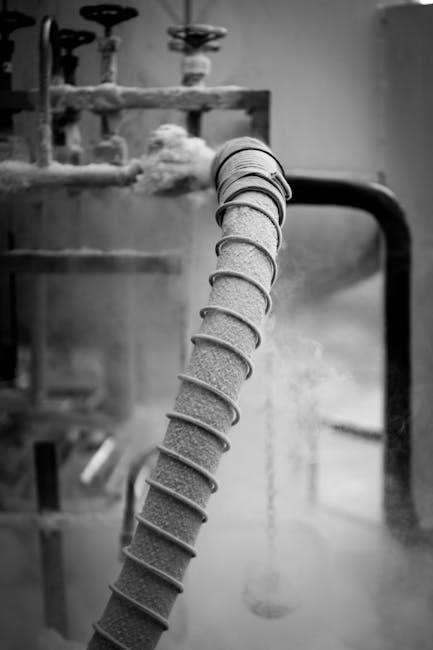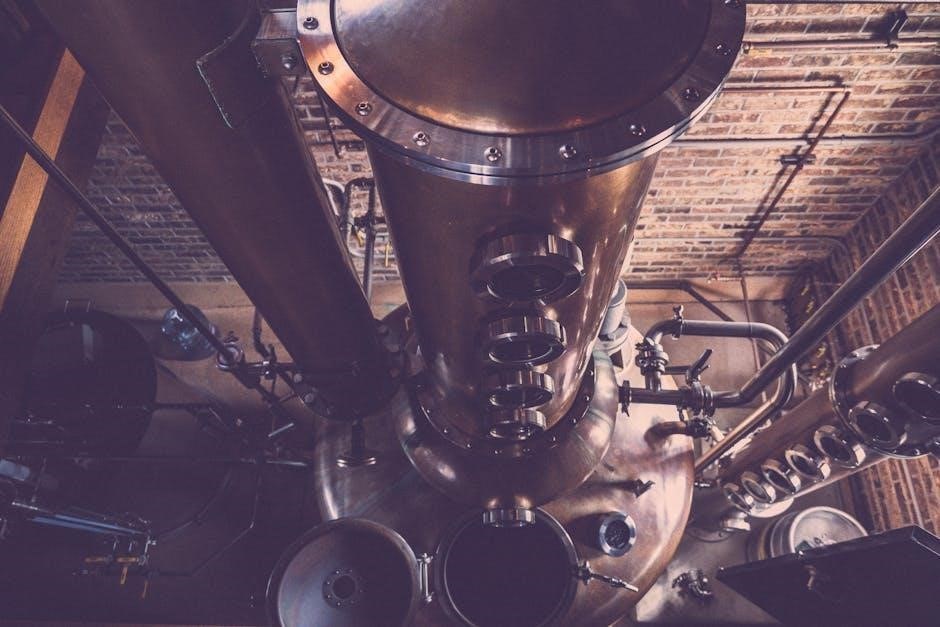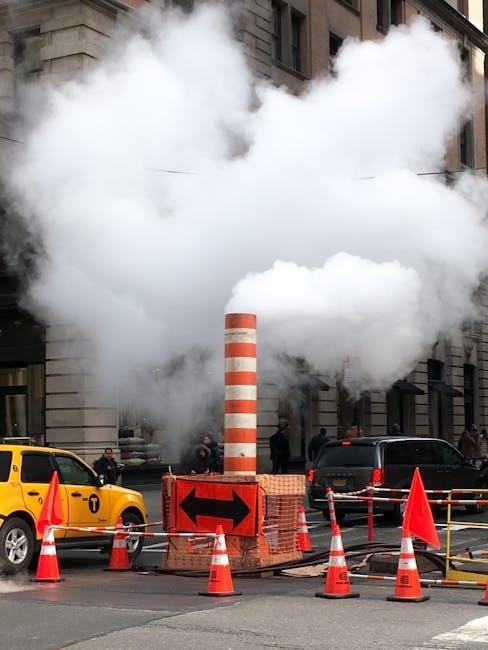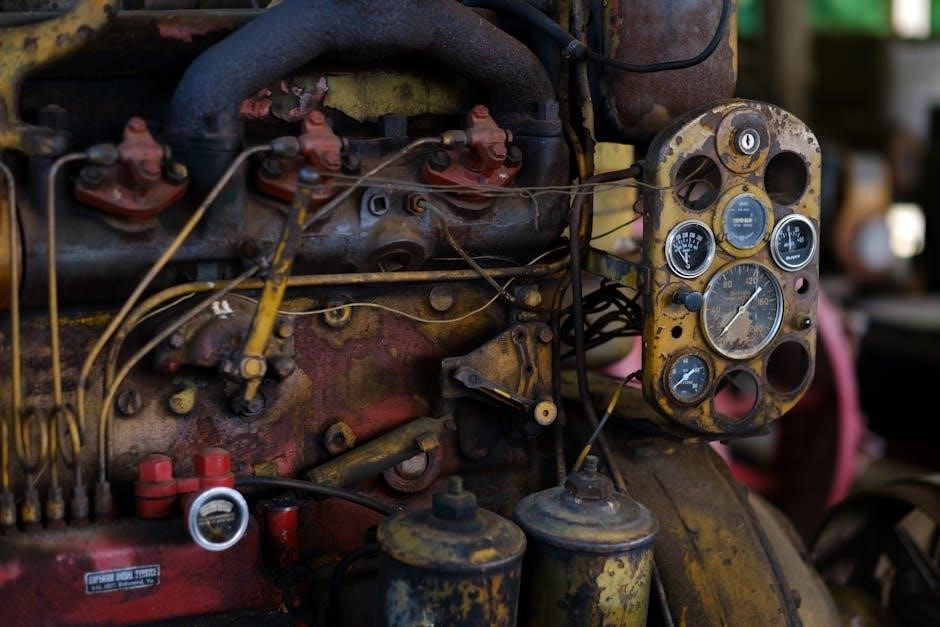Steam boiler piping diagrams provide a visual representation of the piping system, ensuring compliance with safety standards and proper installation. They outline key components, connections, and configurations, aiding in understanding the system’s layout for efficient operation and maintenance.
1.1 Overview of Steam Boiler Piping Systems
Steam boiler piping systems are critical for distributing steam and managing condensate return. These systems include headers, risers, steam mains, and condensate lines, ensuring efficient heat transfer and proper drainage. Piping diagrams illustrate the layout, helping technicians understand connections, flow directions, and safety features like blowdown valves. Proper design ensures system reliability, safety, and compliance with industry standards, while minimizing risks of leaks or inefficiencies.
1.2 Importance of Piping Diagrams for Steam Boilers
Piping diagrams are essential for steam boiler systems, ensuring proper installation, operation, and maintenance. They provide a clear visual guide for technicians, highlighting connections, flow directions, and safety features like blowdown valves. These diagrams help troubleshoot issues, ensure compliance with standards (e.g., ASME), and optimize system performance. They are critical for understanding steam distribution and condensate return, minimizing risks and ensuring safe, efficient operation.

Essential Components of Steam Boiler Piping
Steam boiler piping systems include headers, risers, steam mains, and condensate return lines, ensuring efficient steam distribution and safe operation. Proper sizing and layout are critical.
2.1 Boiler Header and Risers
The boiler header and risers are critical components, ensuring steam flows evenly into the system. Headers must be one size larger than boiler piping, and risers should be at least 24 inches above the water line to prevent water hammer. Proper sizing and layout are essential for efficient steam distribution and safety, adhering to industry standards.
2.2 Steam Main and Branch Piping
Steam main and branch piping distribute steam throughout the system. Mains should be sized to accommodate condensate flow, while branches connect to individual equipment. Proper sizing prevents pressure drops and ensures efficient steam delivery. Counterflow or parallel arrangements are common, with considerations for pipe material and insulation to maintain steam quality and system efficiency. Regular maintenance is essential to avoid leaks and corrosion.
2.3 Condensate Return and Drainage Systems
Condensate return systems collect and return condensed steam to the boiler, improving efficiency and reducing water usage. Proper drainage involves installing traps and ensuring pipes slope correctly to prevent waterlogging. Gravity-fed systems require careful piping to maintain flow, while pumped systems offer flexibility. Regular maintenance prevents corrosion and blockages, ensuring optimal performance and longevity of the steam boiler system.

Near-Boiler Piping Considerations
Proper near-boiler piping ensures safe and efficient steam flow, preventing water hammer and reducing wear. It involves precise sizing, routing, and installation of critical components to maintain system integrity.
3.1 Minimum Height Requirements for Risers
The minimum height for steam risers is crucial to prevent water hammer and ensure proper steam flow. Risers must be at least 24 inches above the boiler’s water line to maintain system stability and efficiency. This height ensures that steam flows smoothly without water carryover, adhering to industry standards like EN 12952 for safe and reliable operation.
3.2 Blowdown Valves and Connections
Blowdown valves are essential for maintaining boiler efficiency and safety by removing sludge and scale. Proper installation ensures effective drainage without disrupting steam flow. Valves must be full-size connections on the boiler, with piping independently supported to prevent strain. Regular maintenance and correct sizing are vital for optimal performance and longevity of the system.
3.3 Skimming and Surface Blow-Down Piping
Skimming taps and surface blow-down piping are critical for removing impurities and maintaining water quality. Proper placement ensures effective skimming without obstructing steam flow. The return piping must be sized appropriately to handle condensate and sludge, ensuring safe and efficient boiler operation. Regular maintenance of these connections is vital for optimal performance and longevity of the system.

Detailed Piping Configurations
This section explores various piping layouts, including one-pipe, two-pipe, parallel, and counterflow systems. Each configuration ensures efficient steam distribution and condensate return, tailored to specific applications.
4.1 One-Pipe and Two-Pipe Steam Systems
One-pipe systems use a single pipe for steam supply and condensate return, relying on natural condensation flow. Two-pipe systems separate steam distribution and condensate return, offering better efficiency and control. Each configuration is detailed in steam boiler piping diagrams, ensuring proper installation and operation for specific applications. Correct sizing and layout are crucial for optimal performance and to prevent issues.
4.2 Parallel and Counterflow Piping Arrangements
Parallel flow systems feature steam and condensate moving in the same direction, while counterflow systems have them moving oppositely. Counterflow piping minimizes condensate pooling and improves heat transfer efficiency; Both configurations are detailed in steam boiler piping diagrams to ensure proper installation and compliance with industry standards, optimizing system performance and reliability. Proper sizing and layout are critical for effective operation.
4.3 Reverse Return Piping for Multiple Boilers
Reverse return piping balances steam distribution and reduces pressure drops in multi-boiler systems. It ensures even steam flow and prevents overloading, improving efficiency. Diagrams illustrate how return lines loop back, maintaining symmetry and minimizing turbulence. This configuration is crucial for maintaining stability and optimal performance in complex steam systems, as detailed in industry standards and best practices. Proper implementation enhances overall system reliability.
Safety and Best Practices in Piping Design
Proper sizing of relief valves, supports, and flexibility in piping design are critical for safety. Avoid over-tightening connections and ensure all piping adheres to local codes and standards.
5.1 Proper Sizing of Relief Valves and Piping
Proper sizing of relief valves ensures safe pressure release and prevents system damage. Piping must match valve discharge size to maintain flow efficiency. Avoid over-tightening to prevent seat distortion. All relief piping should be independently supported, with no weight on valves. This ensures compliance with safety standards and prevents potential hazards in steam boiler systems.
5.2 Support and Flexibility in Steam Piping
Steam piping requires adequate support and flexibility to accommodate thermal expansion and contraction. Proper hangers and brackets ensure stability, preventing pipe sagging and stress on connections. Flexibility in piping design allows for movement without damage, reducing risks of leaks and system failure. Regular inspections ensure supports remain secure, maintaining system integrity and efficiency over time.
5.3 Avoiding Common Piping Mistakes
Common piping mistakes include improper sizing, inadequate support, and incorrect material selection. Over-tightening connections can distort valve seats, while undersized pipes restrict flow. Ensuring proper alignment and avoiding sharp bends reduces turbulence and wear. Adhering to standards and best practices minimizes errors, ensuring safe and efficient steam system operation. Regular training and inspections further mitigate these risks effectively.
Armstrong International Best Practices
Armstrong International recommends optimized piping layouts for steam systems, emphasizing proper flare systems, multiple steam supplies, and storage tank coil configurations to ensure efficient operation and safety.
6.1 Recommended Piping Layouts for Steam Systems
Armstrong International suggests optimized piping layouts for steam systems, emphasizing flare systems and multiple steam supplies. Properly designed systems ensure efficient steam distribution and condensate return. Reverse return piping is recommended for multiple boilers to balance flow and reduce pressure drops. Storage tank coil configurations should prioritize even heat distribution and proper mixing valves. These layouts enhance system performance, safety, and longevity.
6.2 Flare Systems and Multiple Steam Supplies
Flare systems in steam piping ensure proper steam flow distribution, especially in multi-boiler setups. Armstrong International recommends using flare systems for high-pressure applications, such as 150 psig or 10 barg. Multiple steam supplies should be designed with open systems to prevent pressure imbalances. Proper installation ensures efficient steam delivery and maintains system integrity, adhering to safety standards.
6.3 Storage Tank Coil and Mixing Valve Configurations
Storage tank coil configurations ensure efficient heat transfer and proper steam distribution. Mixing valves are recommended for tanks when hot water temperatures exceed 119°F to maintain consistent output. Armstrong International suggests precise coil sizing and valve placement to avoid thermal shock and ensure system stability. Proper configuration prevents water hammer and maintains optimal steam flow.

Industry Standards for Steam Boiler Piping
Industry standards like EN 12952 and EN 13480 ensure safe and efficient steam boiler piping designs. Compliance with ASME and local codes is mandatory for system integrity.
7.1 EN 12952 and EN 13480 Compliance
EN 12952 and EN 13480 standards regulate the design and safety of steam boiler piping systems. These European norms ensure compliance with material, dimensional, and safety requirements. Proper adherence guarantees system reliability and efficiency, minimizing risks. Designers must follow these guidelines to maintain optimal performance and meet legal standards for steam boiler installations and operations. Compliance is crucial for both safety and operational excellence.
7.2 ASME and Local Code Requirements
ASME standards and local codes govern steam boiler piping to ensure safety and efficiency. These regulations specify material grades, piping sizes, and installation practices. Compliance with ASME Section I and local codes is mandatory for boiler operation. Designers must integrate these requirements to prevent hazards and meet legal standards, ensuring reliable and safe steam distribution systems in industrial settings. Proper documentation is essential for compliance verification.
7.3 Standard Details for Boiler Plant Piping
Standard details for boiler plant piping ensure consistency and reliability in system design. These include specific pipe sizes, valve placements, and connection types, as well as requirements for supports and flexibility. Proper documentation and adherence to these standards are crucial for maintaining system integrity and ensuring safe, efficient operation across various industrial applications and boiler configurations. Detailed drawings guide accurate installations.
The conclusion highlights the importance of proper steam boiler piping design for safety and efficiency. Additional resources include manuals, guides, and software tools for detailed piping configurations and compliance with industry standards.
8.1 Summary of Key Piping Considerations
Proper sizing, material selection, and compliance with standards like EN 12952 and ASME are critical for steam boiler piping. Correct installation of components such as risers, headers, and blowdown valves ensures safety and efficiency. Regular maintenance and adherence to best practices like reverse return piping for multiple boilers are essential for optimal system performance and longevity.
8.2 Recommended Tools and Software for Piping Design
For steam boiler piping design, tools like AutoCAD, AVEVA PDMS, and Pipeflo are essential for accurate piping layouts. ROHR2 and Conval aid in flexibility analysis, while LISEGA supports detailed engineering. These tools ensure compliance with standards like EN 12952 and ASME, promoting efficiency and safety in piping systems. Proper software utilization streamlines design and enhances system performance.
